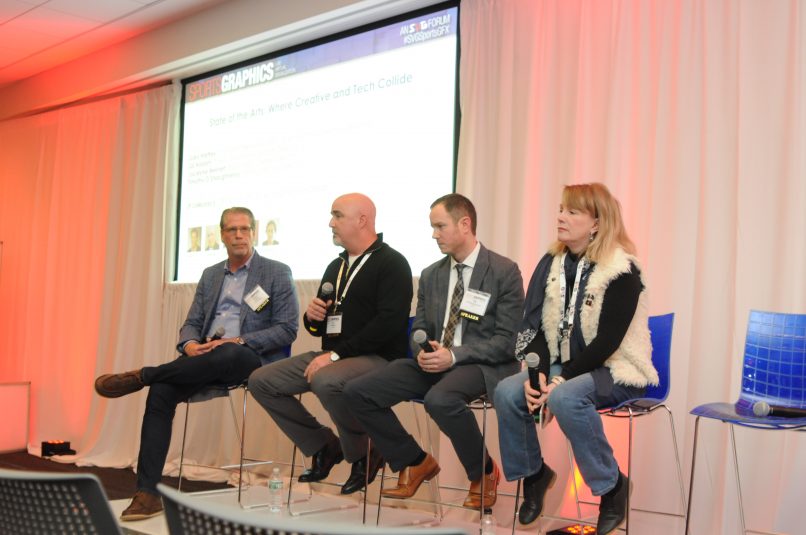Sports Graphics Forum: Multi-Platform Needs Require Disciplined, Inclusive Approach to Graphics Design
Story Highlights
A consistent theme throughout the day at the 2018 SVG Sports Graphics Forum was the continued evolution of graphics design and creation in a multi-platform universe where, increasingly, all platforms are on equal footing when it comes to importance to a client.
“Gone are the days when you would design for the big screen and then hand off tools and elements,” said Jocelyne Meinert, Big Studios, Owner/Director. “Now you need to make sure all the stake holders have consensus in front of the project rather than behind it. You need a kickoff meeting to connect with each platform and understand the opportunities for each platform and then develop for them simultaneously.”

Gary Hartley, Gil Haslam, Tim O’Shaugnessy, and Jocelyn Meinert discussed the future of graphics creation at the 2018 SVG Graphics Forum.
The challenge facing everyone is that budgets are being stretched over multiple platforms and that means there is more pressure to reduce the amount of silos and, instead, encourage more collaboration among a client’s different divisions. In addition, the IT director and the broadcast engineering teams need to establish solid relationships as success often hinges on their ability to communicate with and work with each other. Someone within an organization needs to build those bridges.
“You need someone in the department to control the pipelines and we have found a couple of people who can establish the pipelines and now run a plan through them to build graphics the right way and then backend pipelines for rendering,” added Timothy O’Shaughnessy, ESPN, Creative Director.
He adds that it is important to figure out how a graphical element and brand extends out through the various platforms. For example, when it comes to graphics creation for college basketball, the digital platforms take precedent as consumption on the Web and mobile devices requires graphics that look polished and are flexible enough to be delivered in a wide variety of aspect ratio to different devices and platforms.
Gary Hartley, Fox Sports Networks, EVP, Graphics and Creative Director, said it is only recently that digital has become a prime consideration when it comes to graphic design but that it is having an impact on everything from motion theory and color theory to typography.
Added Gil Haslam, Troika, Executive Creative Director: “Everything flows from the top to everyone else in the system, whether they are working on social, marketing, the game, or the set. It’s brand first and fan first. But you need to step back and dream a little differently.”
A team might also need to step back and be honest about whether or not graphics are being overproduced. The number of graphics elements for a broadcast continues to grow and the number of events that need graphics is also growing. Couple that constant expansion with the pressure to get things done and a graphics team can find itself unable to consider style changes or new ways to work.
“The production philosophy is changing, and a less is more approach is taking over,” said JP LoMonaco, CBS Sports, Vice President, On-Air Graphics & Design. “So, you can end up overproducing and creating more graphics than we need.”
The future of graphics design will also be impacted by new formats like 4K, HDR, VR, and AR.
One issue is that the technology that powers graphics creation has gotten so great at fast rendering times and lowering storage costs that there is no desire to take a step back, slow down the graphics creation process, or increase storage costs for an audience that is too small to justify compromises.
“The technology has gotten exponentially better and now we have real-time rendering,” said LoMonaco. “It’s funny that we hit a place where we are working freely and can build and render graphics quickly. And now we have 4K, 8K, or 1080p HDR and maxing out the systems.”
The key is to avoid having technology slow down the creative process.
“You have to make sure blue-sky ideas push the creative agenda and that technology doesn’t stifle the end product,” said O’Shaughnessy. A database, for example, that lists things like nicknames for not only players but arenas or a list of fight songs help speed up the creative process.
All of the events being produced also means more opinions from the production side and different producers will often have different personalities. Some will want to stick their neck out and push the envelope while others will prefer to pass on complex technologies and instead focus on using graphics to tell a story.
“When you are doing something that has never been done before, either technologically or creatively, you can find pockets of resistance,” said Meinert. “So, you need to get people excited about the project.”
